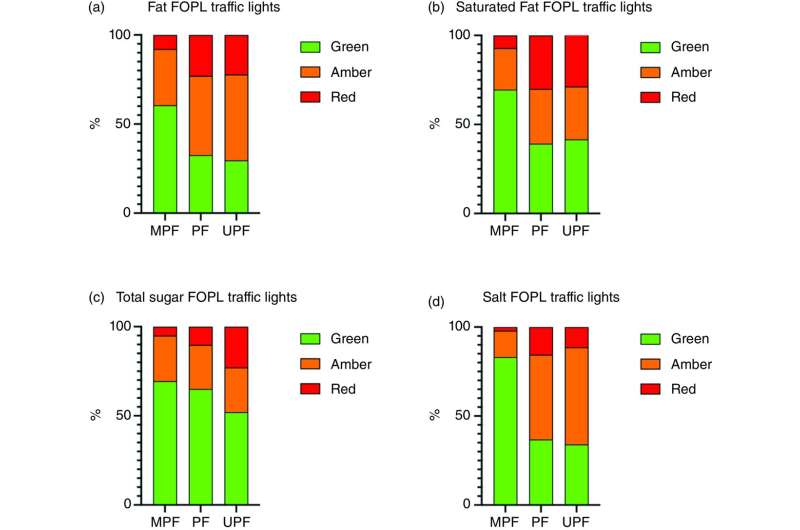This article has been reviewed according to Science X's editorial process and policies. Editors have highlighted the following attributes while ensuring the content's credibility:
fact-checked
trusted source
proofread
Ultra-processed foods score worse on food package labeling

Ultra-processed foods (UPFs) contain more calories, fat, saturated fat, sugar and salt than minimally processed foods—but not all UPFs are unhealthy, according to new research from UCL.
For the study, published in the British Journal of Nutrition, scientists wanted to investigate whether food processing information could be a useful indicator of what is healthy to eat.
The research team compared data on the level of processing in commonly eaten foods to the advice found on food packaging labels—the first time such an assessment has been carried out.
UPFs have been under investigation since the Scientific Advisory Committee on Nutrition (SACN) report on processed foods and health was published in 2023. After reviewing the available scientific evidence, the SACN report concluded that increased consumption of processed foods, in particular UPFs, was associated with an increased risk of health issues such as obesity, chronic diseases like type 2 diabetes, and depression. But the report also cautioned that further research was needed to establish the cause of these associations.
The degree of processing in foods is most often assessed using the NOVA scale, which divides foods into four groups: unprocessed or minimally processed foods, processed culinary ingredients, processed foods, and ultra-processed foods.
But processing information is not currently included in the front of pack labeling system used in countries like the U.K., which uses a "traffic light" system to show the level of energy, fat, saturated fat, sugar and salt contained in foods. In this system, red means high, amber means medium and green means low.
In this study, researchers at UCL looked at data on what people are eating in the UK to assess how well the NOVA scale aligns with the advice on front of pack labeling.
They found that UPFs had worse (unhealthier) pack labeling scores, with greater levels of energy, fat, saturated fat, sugar and salt than minimally-processed foods.
The results also indicated that not all UPFs are unhealthy according to package labeling, with the caveat that they were still unhealthy according to less processed foods.
Processed foods, one step below UPFs on the NOVA scale, also scored badly on front of pack labeling, but were not as high in energy or sugar as UPFs.
Samuel Dicken, first author of the study from UCL Division of Medicine, said, "There is a clear overlap between the healthiness of food, front of pack labeling and the level of food processing. This has implications for understanding what we eat and drink in the U.K.
"What is clear from the types of food and drinks captured by red 'traffic lights' on front of pack labels and wide availability of UPF, is the need to change the food environment to support individuals to consume a healthy, balanced diet. A focus on updating package labeling creates a complicated message, and keeps the burden on the individual."
The lack of data on UPFs means that the jury is still out on whether processing is a useful indicator of healthy diet. Though many UPFs are clearly unhealthy, technically staple foods such as sliced bread and vegan 'meat' products are ultra-processed.
A trial is currently underway at UCL to assess whether it is possible to eat healthily on a UPF-only diet compared to a minimally-processed food diet, and whether providing guidance on healthy eating can change what people choose to eat. The results are expected in early 2025.
Dr. Adrian Brown, the lead author of the study and a specialist dietitian from UCL Division of Medicine, said, "Having worked with patients for nearly two decades, one of the biggest challenges for people is to identify what's healthy and what's not in a supermarket environment. On the face of it, a low-fat yogurt may look healthy for, example, but it may also be high in sugar. Adding that it's also ultra-processed will only make these decisions harder.
"At the moment, things aren't so clear cut as to say all UPFs are bad and there is a risk of confusing people about what is healthy to eat."
More information: Samuel J. Dicken et al, Nutrients or processing? An analysis of food and drink items from the UK National Diet and Nutrition Survey based on nutrient content, the NOVA classification and front of package traffic light labelling, British Journal of Nutrition (2024). DOI: 10.1017/S0007114524000096




















